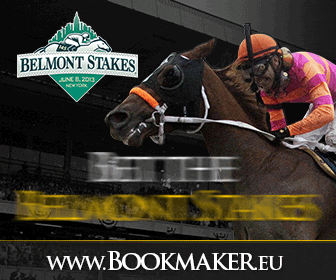| Across The Board: |
Three equal bets, to win, place and show, on one horse. |
| Allowance Race: |
A non-claiming race which has conditions to determine
the horses that are eligible to enter. For example, an allowance race
might be open to horses that have not won three races. |
| Also Eligible: |
An entered horse that will race only if a scratch
occurs (at or prior to scratch time) in the body of the field. |
| Also-Ran: |
Finished out of the money. |
| Apprentice: |
Rookie jockey who receives weight allowances. |
| Backstretch: |
1) The straightaway on the far side of the race track.
2) Area where stables are located. |
| Bear Out: |
To drift or veer out toward the outside of the track. |
| Bit: |
Metal bar that fits in horse's mouth and is attached to
the reins; used for control. |
| Bleeder: |
Horse that bleeds during heavy exertion, usually from
small vessels or capillaries in respiratory system. |
| Blinkers: |
A common piece of racing equipment that contains eye
cups which limit a horse's vision and prevent distraction. |
| Bloodline: |
Pedigree of a horse. |
| Blow Out: |
Workout before a race to limber up a horse. |
| Bolt: |
A sharp left- or right-hand movement by a horse. |
| Book: |
Jockey's record of riding engagements. |
| Break: |
1) The start of a race.
2) To train a young horse to accept saddle, bridle and rider. |
| Break Maiden: |
When a horse gets his first win. |
| Breeze: |
1)To run easily, under a hold, without much
encouragement.
2) A generic expression for a morning workout. |
| Broodmare: |
Female Thoroughbred used for breeding purposes. |
| Broodmare Sire: |
The sire of the dam of a Thoroughbred. |
| Call: |
1) To describe the running of a race.
2) A specific point in a race at which running positions are recorded.
3)A verbal contract between a jockey and a trainer. |
| Card: |
A day's racing program. |
| Cast: |
1) A horse that had laid down or fallen and is unable
to rise.
2) Lost or thrown, such as a horseshoe. |
| Chalk: |
The betting favorite. |
| Chart: |
Result chart that shows all horses and their positions
at various points in a given race along with the time of the race. |
| Chute: |
Extension of the stretch allowing for long, straight
runs from the gate to the first turn. |
| Circuit: |
Tracks whose meets are in sequence, allowing stables to
follow a circuit. |
| Claiming Race: |
A type of race in which the horses are entered for a
specific price and may be purchased (claimed) before the race. A
claiming price helps to classify horses and keep the competition in a
race fairly equal. |
| Clocker: |
One who times workouts. |
| Close: |
To gain ground on the leader. |
| Clubhouse Turn: |
Usually the turn found on the right-hand side of the
track as seen when facing the track from the stands. |
| Colors: |
Jockey silks and cap done in horse owner's colors and
pattern. |
| Colt: |
A male horse that is four years old or younger. |
| Common: |
A reference to a horse which lacks class and/or one
which fails to give a full effort. |
| Condition Book: |
Track publication for horsemen announcing conditions of
upcoming races. |
| Coupled: |
Two or more horses that have the same owners or
trainers are said to be coupled. These horses run as an "entry," and a
bet on one horse automatically includes the other. |
| Cuppy: |
A description of a dirt track surface which is loose
and dry, therefore tending to break away from the horses as they run. |
| Cushion: |
The top level of the racing surface. |
| Daily Racing Form: |
Daily newspaper of racing which provides statistics,
racing news and past performance records of horses competing in races
that day. |
| Dam: |
The mother of a horse. |
| Dark Day: |
A day when a track does not conduct racing during their
regular season. |
| Dead Heat: |
When two horses cross the finish line at the same time
and are inseparable by the photo-finish camera, the race is declared a
tie, or dead heat. |
| Dead Weight: |
Tack and lead slabs that bring rider up to the horse's
assigned weight. |
| Derby: |
Stakes races for three-year-olds. |
| Disqualify: |
To officially lower a horse's actual finish position
due to interfering with other horses, carrying too little weight, not
conforming to conditions of eligibility of having systemic substances
above allowed limits. |
| Dogs: |
Rubber cones placed away from the inner rail on the
turf course during morning workouts in order to prevent wear and tear of
the main portion of course; also sometimes used on dirt tracks when they
are muddy or sloppy. |
| Dwelt: |
When a horse breaks very slow from the gate. |
| Ease Up: |
To slow a horse's stride to prevent undue exertion. |
| Eighth Pole: |
Colored post inside the inner rail exactly one-eighth
mile back from the finish line. |
| Equine: |
A horse. |
| Farrier: |
Blacksmith, one who makes and attaches horseshoes. |
| Fast Track: |
1) Dry racing surface.
2) Description of a dirt surface on which faster than normal times are
being recorded. |
| Field: |
1) Used to describe all the horses in a race.
2) Also when there are more starters in a race than the tote board is
able to show odds for, the remaining horses run as a single betting
option, or "field." |
| Filly: |
A female horse that is fours years old or younger. |
| Foal: |
1) Newborn equine.
2) To give birth. |
| Footing: |
Condition of racing surface. |
| Form: |
1) A horse's current condition.
2) Short for Daily Racing Form. |
| Fractions: |
Clocking of time at intervals in races or workouts. |
| Free-Running Type: |
A horse which tends to take a strong hold of the bit
and pull its way to lead during the early stages of a race. |
| Freshening: |
Layoff or vacation from racing. |
| Furlong: |
One eighth of a mile; most races are measured in
furlongs. |
| Game: |
Determined. |
| Gelding: |
A castrated horse. |
| Genuine: |
Refers to an honest horse; one which gives everything
it has in races. |
| Going Away: |
To win while increasing lead. |
| Good Track: |
A drying track surface between sloppy and fast. |
| Graduate: |
1) To break maiden.
2) To describe a horse which has fulfilled one condition and moves on to
a higher level. |
| Green: |
A description of a horse which is temperamentally
immature. |
| Groom: |
Stable employee assigned to tend to a horse or horses,
including bringing the horse to the paddock for a race. |
| Halter: |
Strap or rope by which horses are led. |
| Hand: |
A horse's height is measured in "hands." A hand equals
four inches. |
| Handicap: |
1) To study the background of racehorses to determine
educated wagering choices.
2) A type of race in which horses are assigned specific weights in order
to bring about an equal contest. |
| Handle: |
The total amount of money wagered. This term could
refer to a particular race, day or season. |
| Heavy Track: |
A running surface drier than muddy and quite slow. |
| Homestretch: |
The stretch of track from the final turn to the finish
line. |
| Horse: |
The term applied to an un-castrated horse that is five
years old or more. |
| Horse's Birthday: |
All horses become one year older on January 1 of each
year for purposes of competition. |
| Horsing: |
A filly or mare in heat. |
| Infield: |
The area within the inner racing surface. |
| In Hand: |
Running under restraint to conserve energy. |
| Inquiry: |
Investigation by officials to determine if a race was
won fairly and without interference. |
| In The Money: |
1) For fans; a win, place or show finish resulting in a
mutual payoff.
2) For owners; a finish resulting in receiving a portion of the purse. |
| Irons: |
Another name for stirrups, where jockeys place their
feet when riding. |
| Jail: |
Refers to the first month a claimed horse is in a new
barn (new owner and trainer) whereby racing rules require it to be
entered at a claiming price above that which it was claimed, should the
new owner wish to race it. |
| Jockey Agent: |
One who secures riding assignments for a jockey in
return for a percent of the jockey's earnings. |
| Journeyman: |
A licensed jockey who has completed his apprenticeship. |
| Juvenile: |
A two-year-old equine. |
| Lead Pad: |
Saddle pad with pockets to hold lead weights;
inserted to bring jockey up to assigned weight. |
| Lead Pony: |
1) Horse on which outrider or pony person escorts
Thoroughbreds onto track and to starting gate.
2) Any horse on the track that will not be racing. |
| Leg Up: |
1) To build a horse's stamina and speed through
exercise.
2) To help a rider up on a horse. |
| Length: |
1)Refers to the length of the average horse.
2) Used to describe the distance between horses when a race is being
run. |
| Live Weight: |
A jockey's weight. |
| Lock: |
An apparent "sure thing," used to describe a horse's
chance of winning. |
| Lugging In: |
Used to describe a horse which is pulling strongly to
the inside while running. |
| Maiden: |
A horse of either sex that has never won a race. |
| Mare: |
A female horse that is five years old or more. |
| Morning Glory: |
A horse which works fast in the morning, but fails to
perform to expectations when racing in the afternoon. |
| Morning Line: |
The track handicapper's estimate of the probable odds
in a race. These odds are printed in the program and posted on the tote
board. |
| Mudder: |
A horse that prefers muddy or sloppy tracks. |
| Muddy Track: |
A surface with a good deal of moisture in it, but
little or no standing water on it. |
| Objection: |
Interference complaint made by a jockey or trainer. |
| Off The Board: |
1) Finished out of the money.
2) Describes the betting action on a horse which is being very heavily
bet. |
| Off Track: |
1) A running surface other than fast.
2) Wagering conducted away from the track. |
| One-Paced: |
A description of a horse with acceleration. |
| One-Run Type: |
A horse which tends to lag toward the back of the pack
during the early stages of a race before mounting a late run. |
| On The Nose: |
A bet to win. |
| Outrider: |
An official on a lead pony who leads the Thoroughbreds
onto the track and to the gate; the outrider enforces the rules
regarding conduct on the track. |
| Overlay: |
Odds higher than they should be, based on horse's
chances of winning. See keep's Handicapping tips for more information. |
| Overnight: |
A listing of the next day's entries. |
| Overweight: |
Weight over the amount officially assigned to a horse
because the jockey is too heavy. |
| Pace: |
The tempo set by the leaders in the early and middle
stages of a race. |
| Paddock: |
The area where horses are saddled prior to a race. |
| Pari-mutuel: |
A system of wagering in which the total money wagered
is distributed to winning ticket holders, less a fixed percentage
returned for race track management, state tax and the racing industry.
So, fans are wagering against each other and not the track. |
| Photo Finish: |
Practice in which a photo is used to determine order of
finish in a race. |
| Plater: |
1) Claiming horse.
2) A farrier. |
| Plodder: |
A slow horse; one which lacks acceleration. |
| Pool: |
The total amount of money wagered on type of bet. |
| Post: |
1) The starting gate.
2) The time a race will begin. |
| Post Position: |
The horse's position in the starting gate, numbered
from the inside rail. |
| Quarter: |
1) Quarter mile, or two furlongs.
2) The side of the hoof. |
| Rabbit: |
A horse which is entered in a race to insure a fast
pace. |
| Racing Secretary: |
The race track official who writes the conditions for
races, and also assigns weights in handicap races. |
| Racing Times: |
A daily racing publication providing statistics,
feature stories and analysis. |
| Rank: |
A description of a horse which fights the rider's
attempt to relax it during the early or middle stages of a race. |
| Ridgling: |
A male equine with one testicle. |
| Route: |
A long race, usually a mile or more. |
| Salute: |
The wave of the whip by jockeys to the stewards after a
race in customary request to dismount. |
| Scale of Weights: |
Official listing of weights carried in a race by horses
according to sex, age, distance of the race and the season. |
| School: |
To train a horse, especially in the paddock and
starting gate. |
| Scratch: |
Withdraw a horse from a race. |
| Set Down: |
1) To suspend a jockey, trainer, etc., from racing for
a specific period of time.
2) To ask a horse for speed. |
| Sex Allowance: |
Weight allowance given to females in races against
males. |
| Shadow Roll: |
Roll of sheepskin strapped across a horse's nose to
keep it from looking down and shying from shadows. |
| Shed Row: |
Track barn area. |
| Shoe Board: |
A sign listing the kind of shoes to be worn by each
entrant. |
| Shut Out: |
Failing to get a bet in before the race begins. |
| Silks: |
Jockey's jacket and cap, also called colors. |
| Sire: |
The father of a horse. |
| Sloppy Track: |
A running surface in which water stands on the surface
prior to sinking in and running off. |
| Slow Track: |
A running surface wetter than good but not as thick as
muddy or heavy. |
| Sophomore: |
Three-year-old equine; termed a sophomore because
horses don't start racing until they are two years old. |
| Sound: |
Free of physical problems. |
| Sprint: |
A short race, usually 7 furlongs or less. |
| Stewards: |
Three racing officials, who apply racing law to human
and equine conduct at a race meet. |
| Stud: |
A breeding stallion. |
| Sucker: |
Refers to a horse which has the ability to win races
but fails to go through with its run when faced with the prospect of
taking the lead. |
| Tack: |
The equipment that goes on a horse along with the
jockey. |
| Take Out: |
The money deducted from each wagering pool and
apportioned to the state and the track. |
| Take Back: |
To restrain a horse back off the pace. |
| Take up: |
To pull a horse up sharply during the running of a race
in order to avoid making contact with another horse. |
| Tele-timer: |
Electronic timer that flashes on the tote board; it is
activated by breaking a light beam. |
| Tongue Strap or Tie: |
A cloth or leather band used to tie down a horse's
tongue to prevent the tongue from interfering with breathing during a
race or workout. |
| Tote Board: |
Located in the infield, it provides odds to win on each
entrant in a given race, plus individual and total amounts wagered to
win, place and show; also provides fractional times of race, minutes to
next race and other information. |
| Turn of Foot: |
Acceleration. |
| Underlay: |
An underlay is a over bet horse. See Keep's handicapping
tips for more information. |
| Ungenuine: |
Refers to a horse which fails to put forth a full
effort, especially during the critical stages of a race. |
| Unsound: |
Suffering from physical ailments. |
| Valet: |
One who takes care of a jockey's clothing and equipment
and delivers his tack to the paddock. |
| Weanling: |
A newly weaned horse. |
| Weight: |
Refers to the weight assigned to each horse. Includes
the jockey, his saddle, and other equipment. Lead weights are carried in
saddle bags if needed. |



